Picture tall spikes of green covered in funnel-shaped blooms that peel outward or droop down just a hint. Splash on frilly edges and ruffles and a menagerie of colors ranging from yellow to pink, red to purple, white to orange, green to purple, and even multi-colored blooms. Now, you’ve begun to envision the beauty of the gladiolus.
More than 250 to 300 species of these gorgeous flowering plants exist in the world, with thousands of cultivars and varieties varying their aesthetics. Choosing the right ones for your garden could be challenging due to the huge range of options. So, we’ve created a list of some of the best and brightest for your growing pleasure.
Reasons You Might Grow Gladioli

Vivid colors splash across the many types of gladiolus when in full bloom.
©iStock.com/Jareck
Four main places come to mind for growing these vivaciously blooming gladiolus bulbs.
Bee Gardens
Gladioli make for stunning and effective blooms in a pollinator garden. The bright colors and pollen draw in hummingbirds, bees, butterflies, moths, and other pollinator insects and animals throughout their blooming season.
Cutting Gardens
Because of the long stems and heady good looks, gladioli are often grown in cutting gardens. They make for incredible cut flowers in bouquets, wedding arrangements, and similar.
Container Gardens
Even for those unable to keep a traditional garden due living situations or energy levels, gladioli are still on the table. Or rather, in the container. Dwarf varieties of gladioli thrive in container gardens, when properly cared for and planted in deep enough pots that contain drainage holes.
Veggie Gardens
Many folks opt to plant some gladioli corms in their vegetable gardens to brighten up the rows. They can help draw in more pollinators towards those edible plants, as well, which certainly isn’t a bad thing.
Gladioli Facts
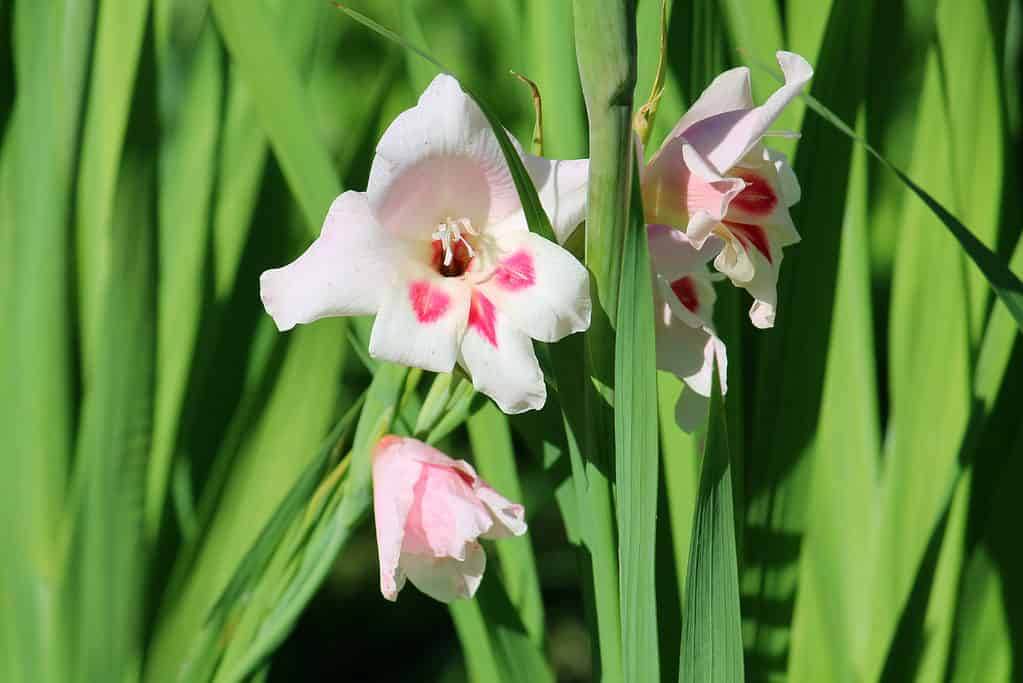
The gorgeous blossoms come in many colors, including bi-color and multi-color forms.
©iStock.com/kazakovmaksim
Showy blooms with narrow leaves decorate most gladioli plants, in vivid colors and unique forms, with somewhere around 300 species dripping their loveliness out of tall spiky stems that may reach as high as 5 feet. The sword-like leaves give the plant their name, from the Latin, meaning “small sword” and earning the plant its nickname of “sword lily.”
Cold hardy, nearly every species of glad may thrive in USDA Growing Zones 8 to 11 and some in 5 to 10. The plant is classed as a summer bulb, with three standard types of the plant:
- Gladiolus grandiflora and its hybrids
- Gladiolus nanus and its hybrids
- Gladiolus Primulinus and its hybrids
Species, Types, and Cultivars of Gladioli
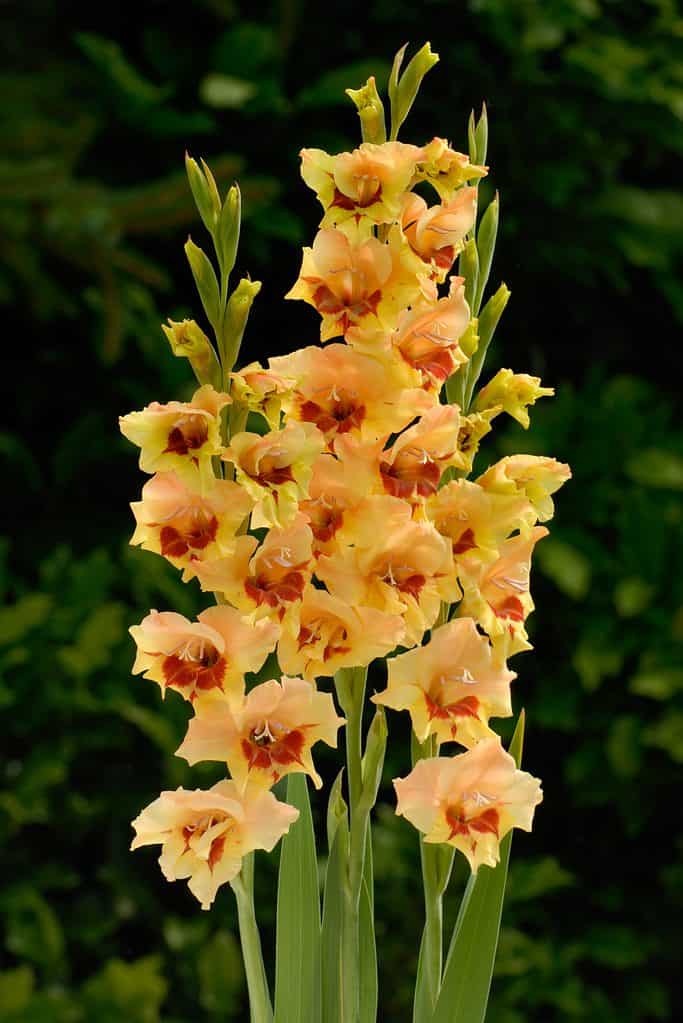
The ‘Safari’ gladiolus is stunning.
©Walter Erhardt/Shutterstock.com
Literally thousands of types of gladioli exist, thanks to the inventive work of many botanists over the years. The popular spiky flowering plants come in all sorts of forms and colors, as well, including:
- Light yellow
- Deep yellow
- Orange
- Tangerine
- Peach
- Lime green
- Deep blue
- Pale purple
- Deep purple
- White
- Red
- Golden orange
- Pink
- Blush
- Rose pink
- Salmon
- Raspberry red
- Burgundy
- Medium blue
- Many bi-color forms
1. ‘Prins Claus’
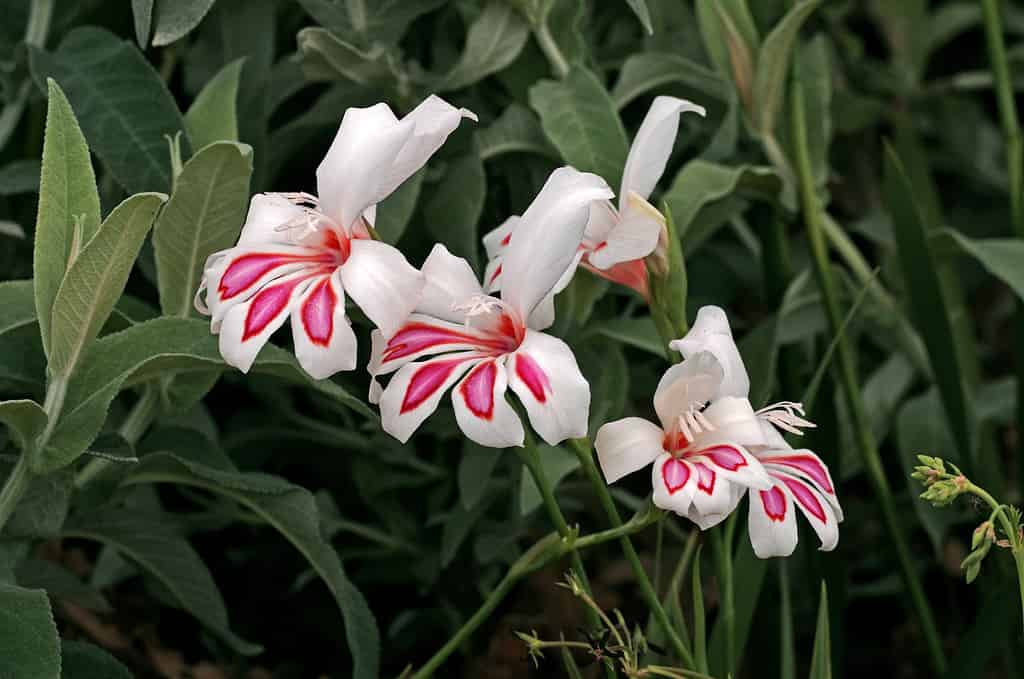
The vivid Prins Claus has striking red and pink markings on the petals.
©Gardens by Design/Shutterstock.com
A pure white flower with vivid leaf-shaped fuchsia markings is the Gladiolus ‘Prins Claus’. A hardy plant with spikes typically 3 feet tall, the plant blooms early in summer with white and pink blossoms all the way into autumn. They are winter hardy and grow in USDA Growing Zones 5 to 11.
2. ‘Black Pearl’
Dramatic beauty accompanies the uniquely dark burgundy-black funnel-shaped blooms on the Black Pearl Gladiolus. The spikes reach 4 feet in height and shoot out numerous blooms that contrast beautifully with the light green of their leaves.
3. Gladiolus Imbricatus

Magenta or deep pink blooms make the Imbricatus a vivid garden selection.
©Iva Vagnerova/Shutterstock.com
With slender, trumpet-shaped blooms in magenta or deep pink, the Gladiolus Imbricatus has slightly ruffled margins, and white stripes along the lower petals, and is commonly known as the Shingled Gladiolus. The plant hits between 1 and 4 feet tall in most cases and is winter hardy t USDA Growing Zone 5.
4. ‘Priscilla’
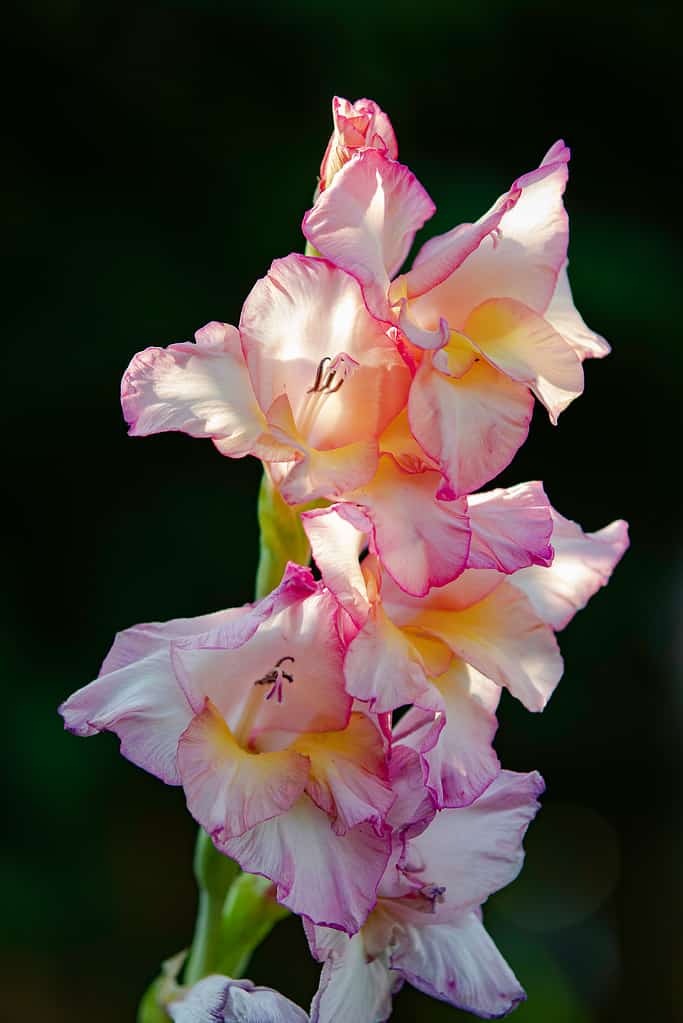
Priscilla has pink fringed blooms.
©JNix/Shutterstock.com
Bold pillars of multi-colored blooms in light yellow, white, and pink greet the eye when Priscilla comes into view. The striking blooms play with ruffled margins as they prolifically grow on long spikes. The pastel flowers grow along stems of 4 to 5 feet in height and often last for 2 weeks. To extend their blooming time, plant successively every two weeks in the planting season.
5. Gladiolus Illyricus
Known as the wild Gladiolus, the Illyricus has a dark lilac or magenta bloom full of large petals on the stem. White streaks run along the petals, helping to make them easily identifiable on the 10-inch stems. The variety is cold hardy in USDA Growing Zones 5 to 10, as long as they’re in well-draining soil.
6. ‘Star of Bethlehem’
The holiday-themed flowers known as Gladiolus Star of Bethlehem pop with stunning vibrant white, wavy petals with contrasting lilac or pale pink throat. The upward-growing blooms cover the stalks with many blooms, making them favorites among cutting gardens.
7. Italian Gladiolus ‘Italicus’
Known as the Italian Gladiolus, or the Italicus, this variety of gladioli has a hooded pink-purple blooms with white patterns that pop out along the lengthy stems. The flowers have green throats and long purple stamens, making them exceptionally easy to identify, with loose spikes up to 3 feet in height and a spread of 4 to 6 inches in width.
8. Red-Lime Hybrid
An unusually colored hybrid is the Red-Lime. The showy blooms come in deep orange and pale yellow-green funnel-shaped blooms with ruffled margins. The green rests on the lower petals with orange tips.
9. Gladiolus Communis ‘Byzantinus’

The bold magenta blooms of the Gladiolus byzantinus thrive in USDA Growing Zones 7 – 10.
©Olga S photography/Shutterstock.com
A subspecies of gladioli, the Communis Byzantinus offers up magenta-rich funnel flowers growing along a 3-foot stalk. They thrive in USDA Growing Zones 7 to 10 with late spring and early summer blooms playing against the vibrant greenery.
10. ‘Peter Pears’
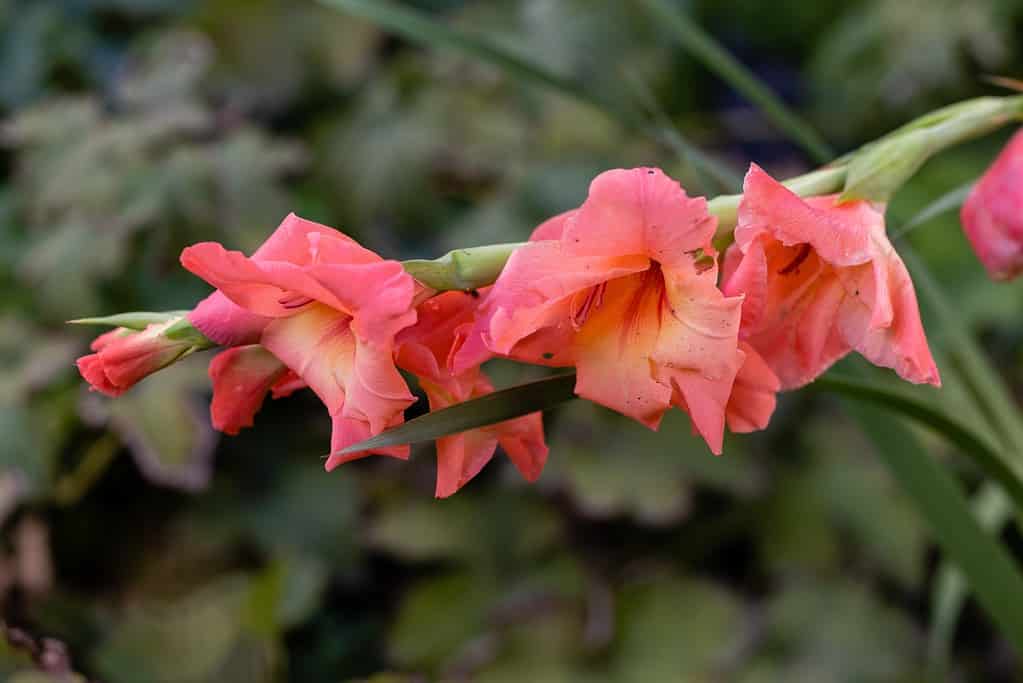
Peter Pears Gladiolus is named for the English tenor of the same name.
©Jose Luis Vega/Shutterstock.com
Pronounced like “peers” and named for the English tenor of the same name, the Peter Pears Gladiolus produces vivid orange blossoms with golden throats and strawberry red edging. The plant will reach 4 feet in height.
11. ‘Lucky Star’
If you long for a fragrant gladiolus but have never seen one, you’re in luck with the Lucky Star Gladiolus. This beauty was the first fragrant gladiolus plant among cultivators for a long, long time. The vivid plant hits 4 feet in height and must have well-draining soil.
12. ‘Green Lace’
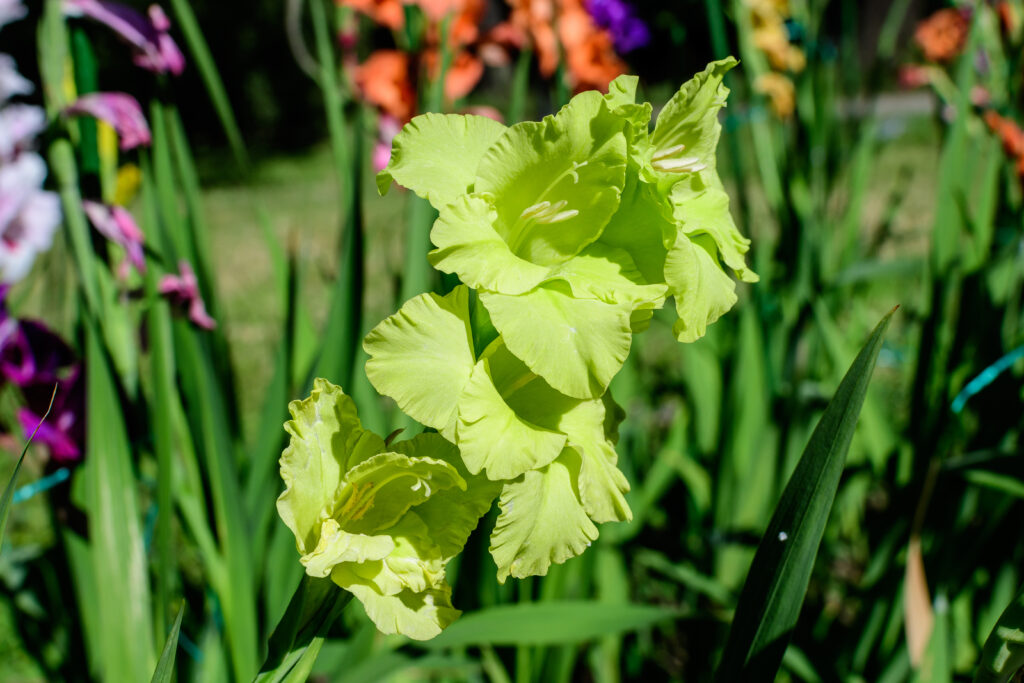
The Green Lace gladiolus is a show-stopper with its unique, vivid green blooms.
©iStock.com/Cristina Ionescu
Unusual in color, the vivid spring green Green Lace Gladiolus is a stunningly unique flower with dainty ruffled edges. The stunner grows to between 3 and 4 feet in height and steals all the attention from visitors witnessing it for the first time.
13. Dauntless Gladiolus
Recalling times of yore with its smooth, angular blooms, the Dauntless Gladiolus is a dramatic blooming pink flower with a rich, ruby throat. It’s a traditional glad that grows up to 4 feet in height and thrives in well-draining soil and full sun.
14. Wine and Roses
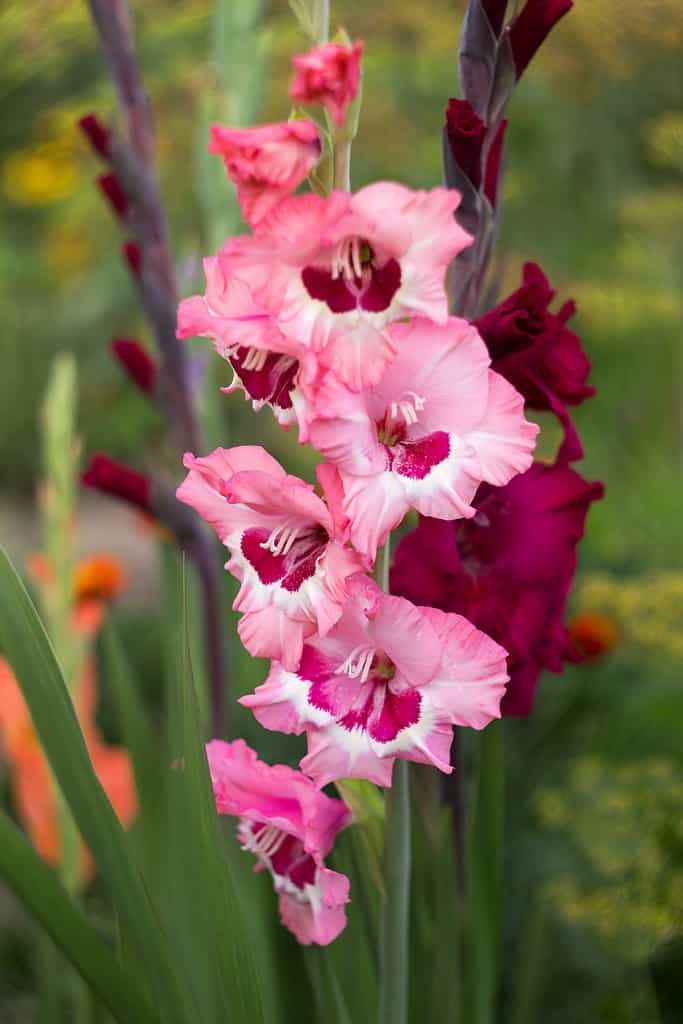
Wine and roses gladiolus grows up to four feet with long-lasting, large blooms.
©Nikilev/Shutterstock.com
Shell pink blooms with splashes of white and burgundy make the wine and roses gladiolus one to remember. The traditional glad is on the larger (but not giant) size, growing up to 4 feet with long-lasting, large blooms.
15. Gladiolus ‘Sericovillosus’
Covered in tiny, dark red speckles, the white blooms of the Gladiolus Sericovillosus are a stunning choice for the garden or container. From a short distance, the flowers appear maroon-pink or even brown, but up close the blooms are complex and stunning. They thrive in USDA Growing Zones 8 to 10 and bloom in summer.
Summary of 15 Types Of Gladiolus Bulbs
| Gladiolus | Color | |
|---|---|---|
| 1 | Prins Claus | Pure white with leaf-shaped fuschia markings |
| 2 | Black Pearl | Dark burgundy-black |
| 3 | Gladiolus Imbricatus | Magenta or deep pink |
| 4 | Priscilla | Mult-colored blooms of white, light yellow, and pink |
| 5 | Gladiolus Illyricus | Dark lilac or magenta |
| 6 | Star of Bethlehem | Vibrant white with lilac or pale pink throat |
| 7 | Italian Gladiolus | Hooded pink-purple blooms with white patterns |
| 8 | Red-Lime Hybrid | Deep orange and pale yellow-green |
| 9 | Gladiolus Communis ‘Byzantinus’ | Bold magenta |
| 10 | Peter Pears | Vivid orange blossoms with golden throats and strawberry-red edging |
| 11 | Lucky Star | Fragrant white with a Fuschia star pattern |
| 12 | Green Lace | Vivid pale lime-green |
| 13 | Dauntless Gladiolus | Pink with a ruby throat |
| 14 | Wine and Roses | Shell pink blooms with splashes of white and burgundy |
| 15 | Gladiolus ‘Sericovillosus’ | White blooms covered in tiny, dark-red speckles |
The photo featured at the top of this post is © iStock.com/Olga Niekrasova
Thank you for reading! Have some feedback for us? Contact the AZ Animals editorial team.






